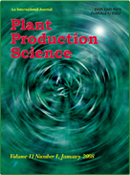Volume 6, Issue 2
Displaying 1-8 of 8 articles from this issue
- |<
- <
- 1
- >
- >|
Crop Physiology and Ecology
-
2003 Volume 6 Issue 2 Pages 107-111
Published: 2003
Released on J-STAGE: May 28, 2004
Download PDF (604K) -
2003 Volume 6 Issue 2 Pages 112-118
Published: 2003
Released on J-STAGE: May 28, 2004
Download PDF (822K) -
2003 Volume 6 Issue 2 Pages 119-125
Published: 2003
Released on J-STAGE: May 28, 2004
Download PDF (560K) -
2003 Volume 6 Issue 2 Pages 126-131
Published: 2003
Released on J-STAGE: May 28, 2004
Download PDF (775K)
( Short Report )
-
2003 Volume 6 Issue 2 Pages 132-133
Published: 2003
Released on J-STAGE: May 28, 2004
Download PDF (283K)
Cell and Molecular Biology
-
2003 Volume 6 Issue 2 Pages 134-138
Published: 2003
Released on J-STAGE: May 28, 2004
Download PDF (885K)
Agronomy
-
2003 Volume 6 Issue 2 Pages 139-146
Published: 2003
Released on J-STAGE: May 28, 2004
Download PDF (462K) -
2003 Volume 6 Issue 2 Pages 147-153
Published: 2003
Released on J-STAGE: May 28, 2004
Download PDF (554K)
- |<
- <
- 1
- >
- >|
